|
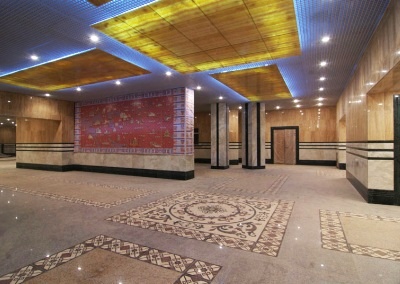 |
After 23 years of construction, the metro in the largest city of Kazakhstan opened and turned out to be of good aesthetic quality. Apparently in the tradition of the gorgeous Soviet metro systems, many stations have walls and floors of polished natural stone.
Photo [almatymetro.kz]: Concourse of Zhibek Zholy station (opened in 2011), marble floor ornamented like an Oriental rug. |
 |
There are works of art or interesting archeological exhibits in several of the metro stations. Some of the newer stations have even been turned into downright museums [tourtripgreece.gr], [ametro.gr].
Photo [untergrundbahnen.de]: The large upper concourse hall of Syntagma station (opened in the year 2000) with its murals and lots of archaeological displays. |
 | Photo: Replica of Parthenon friezes in the entrance hall of Akropoli station, which has been opened in 2000. |
 | Photo [untergrundbahnen.de]: Ethniki Amyna station (line L3), opened in the year 2000, with the art installation Underground Park by Kostas Tsoklis. |
 |
The new lines L9 and L10 boast some interesting stations. Throughout the network, there are more occasional noteworthy stations like La Pau on Line 2.
Photo [DavoR, urbanrail.net]: Fondo station from 2010 on Line 9.
 More Barcelona photos... More Barcelona photos... |
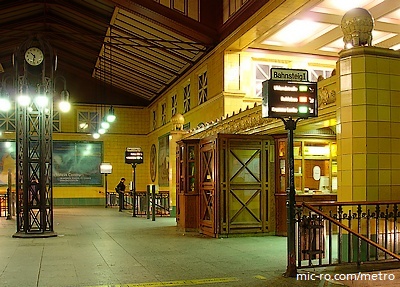 |
The Swedish architect Alfred Grenander has designed more than seventy underground and elevated station buildings in Berlin. His style evolved from Decorative to Modernist between 1902 and 1930 [untergrundbahn.de], [berliner-untergrundbahn.de].
Photo: Refurbished entrance building of Wittenbergplatz station, built in 1913 by Alfred Grenander. |
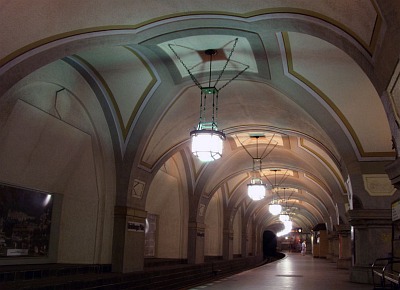 | The co-financing of the U-Bahn line to Dahlem (called U3 today) by the posh district of Wilmersdorf facilitated a prestigious architecture in some stations.
Photo [Daniel Erler, absence-of-fear.de]: Heidelberger Platz station from 1913 by Wilhelm Leitgebel. |
 | Most of the newer stations in Berlin are by Rainer G. Rümmler. Designs range from 1960s Minimalist style and colourful 1970s Pop Art design to Postmodernism.
Photo [u-bahnbilder.de]: Postmodernist-style Rathaus Spandau station from 1984 by Rainer G. Rümmler.
 More Berlin photos... More Berlin photos... |
 |
Most new stations have been designed by Sir Norman Foster in 1995. The underground stations have striking roofed glass entrances. They are nicknamed 'fosteritos' after the architect and shelter escalators or stairways [arcspace.com], [metrobilbao.net], [urbanrail.fotopic.net]. The corporate logo as well as the Rotis typeface, which is used for all signs and paperwork, are by Otl Aicher, 1989 [metrobilbao.net].
Photo: A fosterito at Abando station. |
 | Foster about his spacious concrete vaults: "A tunnel dug by man through earth and rock is a very special place. Its shape is a reaction to the forces of nature and the texture of its construction bears the seal of man. This must be respected, not covered up to make the place look like any other building. One must be able to feel being underground, and make it a good, special experience" (quoted from Metro Bilbao's Touristic Guide Map).
Photo: Barakaldo station built in 2002.
 More Bilbao photos... More Bilbao photos... |
 |
The city encourages art in all metro stations [bsubway], [stib.irisnet.be].
Photo [C.A.I.D.]: Art installation with flying figures by Paul van Hoeydonck in Comte de Flandre station. |
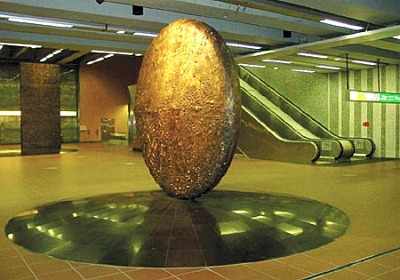 | Photo [stib.irisnet.be]: "De Odyssee" sculpture by Martin Guyaux in Kruidtuin station.
 More Brussels photos... More Brussels photos... |
 |
Hungary's capital boasts the first subway on the European continent. Line 1 (also known as 'Földalatti' or the Millennium Underground) was built in 1896 and added to Budapest's UNESCO World Heritage entry in 2002 [unesco.org]. Old stations have been beautifully restored and some of the modern stations on the other lines are also worth a look.
Photo [natureblink.com]: Hösök Tere station, built in 1896. |
 |
The elevated and at-grade Dubai Metro stations combine both heritage and modern designs. They have been modelled on the shape of seashell, inspired from the diving and pearl-fishing heritage of the UAE, while the interior design depicts the four elements of nature – water, air, earth and fire. [FlashyDubai.com]
Photo [momentaryawe.com, flickr.com]: Mall of the Emirates station. |
 | Conceptual design of some stations includes traditional architectural ingredients used in antique Arab buildings such as wind towers, oriels, alleyways or internal arches.
Photo [Imre Solt, imresolt.com]: Al Jafiliya station. |
 | Photo [Nepenthes, wikipedia.org]: Khalid Bin Al Waleed transfer station with its blue interior and jellyfish-shaped chandeliers. |
 |
A weird subway entrance, looking like a train bursting through the sidewalk from below, is located in Frankfurt. Architect Zbiginiew Peter Pininski reported he felt inspired by surrealist artist René Magritte when creating it [neuer-weg.com]. Some other stations have interesting designs as well [vgf-ffm.de (PDF)].
Photo: Bockenheimer Warte station entrance from 1986.
 More Frankfurt photos... More Frankfurt photos... |
 |
The elevated and underground stations of this small Italian metro system have been designed by the world-famous, Genoa-born architect Renzo Piano in 1983 [materia.it].
Photo: Brin station, which was opened in 1990.
 More Genoa photos... More Genoa photos... |
 |
After decades of ignoring design aspects and thoughtlessly polluting station interiors with giant advertising billboards, there's evidence that metro operator HHA is gradually rediscovering the value of its architectural heritage and developing fresh ideas.
Photo: Klosterstern station from 1929 on line U1, accurately restored in 1986 back to its original style. |
 | Some historic stations have been preserved, and a few featureless stations have recently been transformed into spaces with interesting design and less advertising [100-jahre-hochbahn.de].
Photo: St. Pauli station from 1912. Since 1999, a deconstructivist glass roof contrasts with the historic sandstone entrance and shelters it from weather influences. The historic design at platform level has not been preserved, however.
 More Hamburg photos... More Hamburg photos... |
 |
Metro tram operator Uestra has invited world-famous designers and architects to enhance the looks of the system: the 'Busstops' art project of 1992 resulted in nine remarkable bus and tram stops at street level [uestra.de (PDF)]. Jasper Morrison has designed new trains in 1997, and Uestra's headquarters is a twisted cuboid by Frank O. Gehry.
Photo: Kröpcke station from 1975, once dreary, was completely refurbished in 2000 with designs by Massimo Iosa Ghini.
 More Hanover photos... More Hanover photos... |
 |
Metro art is not too obvious in Hong Kong, but MTR's Art in Stations initiative brings works of art into the stations since 1998. There's an Open Gallery project on the Island Line and in many of Hong Kong's metro stations, live performances and art exhibitions take place [mtr.com.hk].
Photo: Upper platform level of Tsing Yi station with the huge yet inconspicious 'Birds of a Feather' installation by Neil Dawson.
 More Hong Kong photos... More Hong Kong photos... |
 |
The second largest city in Taiwan got a modern MRT system in 2008. There's some interesting architecture found in the stations and station entrances.
Photo [Hiroshiken, flickr.com]: Entrance of Central Park station on the Red Line by Richard Rogers, 2008. |
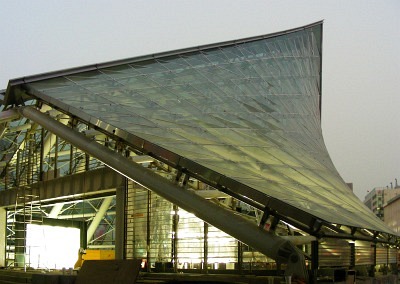 | Photo [Hiroshiken, flickr.com]: One of four symmetrically arranged entrance structures at Formosa Boulevard station in Kaohsiung. |
 | Metro operator KRTC is also taking public art in metro stations seriously [krtco.com.tw]. Kaohsiung International Airport station bears a glass artwork by artist Lutz Haufschild.
Photo [Hiroshiken, flickr.com]: Formosa Boulevard station with its huge Dome of Light by artist Narcissus Quagliata. |
 |
The metro in Kazan was the first one newly built in Russia after the collapse of the Soviet Union. So far, it has a handful of stations only, but all of them are spectacular. Extensions are on the way.
Photo [Parovoza; skyscrapercity.com]: Kremlyovskaya station from 2005. |
 | Photo [skyscrapercity.com]: Prospekt Pobedy ('Victory Avenue') station from 2008. |
 |
The metro in Ukraine's second largest city was inaugurated in 1975 and consists of about 30 stations, many of them with interesting architecture and lighting and built with materials like marble and granite.
Photo [Alexei Bobko, urbanrail.fotopic.net]: Sovetskoj Armii station from 1978. |
 |
The capital of the Ukraine boasts a spectacular metro with three lines and stations similar to other cities in the former Soviet Union [metro.kiev.ua], [urbanrail.fotopic.net].
Photo [Daniel Erler, absence-of-fear.de]: Platform level of Zoloti Vorota (Golden Gate) station. |
 | Kiev's stations are diverse in design. Apart from those in traditional soviet-style magnificence there are a couple of rather futuristic ones.
Photo [metropoliten.kiev.ua]: Platform level of Pecherskaya station. |
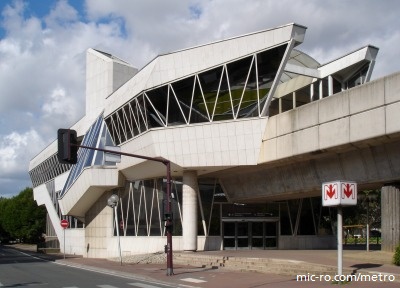 |
Since 1983 this city in Northern France has its VAL metro which is the world's most extensive driverless metro system. Many of the elevated stations are remarkable buildings.
Photo: Porte de Valenciennes station. |
 | All metro stations in Lille are designed distinctly and come in a wide variety of architectural shapes. Most of the stations are underground. Many works of art can be found in Lille's VAL system, including sculptures and murals.
Photo: Platform level of Gare Lille Europe station with huge murals and a reflecting pool. |
 | Building materials include different kinds of natural stone, stainless steel, wood, bricks or tiles. In one station (Montebello), live fish in aquariums at platform level provide an interesting distraction for waiting passengers.
Photo: Platform level of Montebello station with aquariums on the walls and wooden parquet flooring.
 More Lille photos... More Lille photos... |
 |
Works of contemporary art have been included in all metro stations [metrolisboa.pt 1]. Often are Portuguese tiles involved in some way [metrolisboa.pt 2].
Photo [David Pirman, nycsubway.org]: Platform level of Olaias station, which has been designed by the architect Tomás Taveira and a group of artists. |
 | Some stations in Lisbon are dedicated to themes. Parque station symbolizes the achievements of the Portuguese discoverers [inscrire.com].
Photo [unknown origin]: Parque station from 1994 on the Blue Line. |
 | Cabo Ruivo station in Lisbon looks like a space station with its skeleton-like arches. The wall decoration, in contrast, resembles caveman paintings.
Photo [unknown origin]: The walls above the platform of Cabo Ruivo station on the Red Line. |
 |
London's Underground ('tube') was not only the world's first metro but also the first to have a corporate design, including the Johnston typeface (Edward Johnston 1916), the roundel logo (Frank Pick 1918), and the diagrammatic map (Henry C. Beck 1933). This groundbreaking concept is still in use today almost unmodified [ltmuseum.co.uk] and has influenced many other metros.
Photo: Notting Hill Gate station on the Circle Line, dating back to 1868. |
 | There are some examples of interesting station architecture in London outside the city centre. Charles Holden is responsible for the design of fifty underground stations as well as London Transport's headquarters at 55 Broadway [tube.tfl.gov.uk]. For the Piccadilly Line stretch to Cockfosters, Holden developed a modernist approach in the 1930's. The original art deco furnishing of that time is surviving in some of the stations.
Photo: Cylindrical entrance building of Southgate station, built in 1933. |
 | There are works of art in some of London's tube stations [tube.tfl.gov.uk]. The Jubilee Line Extension's spacious stations built in 1999 have been distinctly designed by a couple of famous architects, including Foster & Partners, Ian Ritchie and Michael Hopkins [tube.tfl.gov.uk], [lrb.co.uk], [trainweb.org], [wilson].
Photo: The daylit intermediate concourse of Southwark station (1999) by McCormac Jamieson Prichard architects.
 More London photos... More London photos... |
 |
The city allocated 0.5% of subway construction costs to the creation of original art works. More than 250 artists have contributed. There are works of art in all stations of the Red and Purple Lines as well as many other stations [metro.net], [mta.net], [usc.edu].
Photo [Eric Haas, nycsubway.org]: Hollywood/Highland station by Dworsky Associates architects and artist Sheila Klein. |
 | Hollywood/Vine station on the Red Line features Hollywood's golden history with original theater projectors from the 1930s presented like sculptures. Film reels cover the vaulted ceiling all over.
Photo: Hollywood/Vine station from 1999 by artist Gilbert Lujan and architect Adolfo Miralles.
 More Los Angeles photos... More Los Angeles photos... |
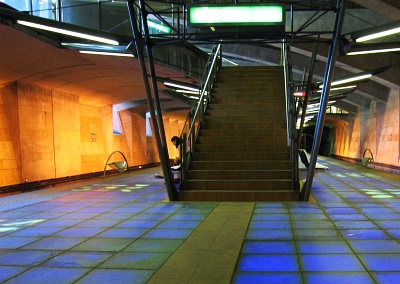 |
The metro of France's second largest conurbation has some interesting stations. Older ones (the metro opened in 1978) are more uniform but on the extension of line B and on the new line D, attention was given to more interesting design and stations have been planned by different architects.
Photo [wikimedia.org]: Valmy station from 1997 on the fully automated line D with a platform illuminated from below. |
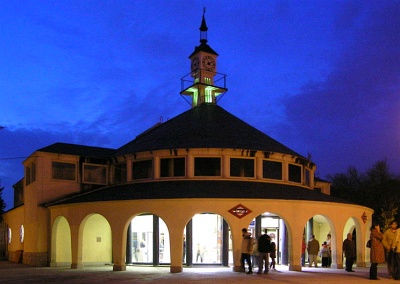 |
Of approximately 300 km of metro lines in Spain's capital, more than 100 km have been built in just a few years around the turn of the millennium. Many of the newer stations and some of the older ones have interesting designs or architecture.
Photo [wikimedia.org]: Entrance building of Lago station of 1961. |
 | Photo [unknown origin, skyscrapercity.com]: Nuevos Ministerios station in Madrid, inaugurated in 2002. |
 |
Like other metro systems in the former Soviet Union, the stations have been built using exquisite materials and a few are decorated with socialist-style reliefs.
Photo [Alexei Bobko, urbanrail.fotopic.net]: Traktorny Zavod station. |
 | Several of the stations in Minsk seem to have a certain 'light-weight' feel that makes one forget that they are underground.
Photo [Alexei Bobko, urbanrail.fotopic.net]: Molodezhnaya station. |
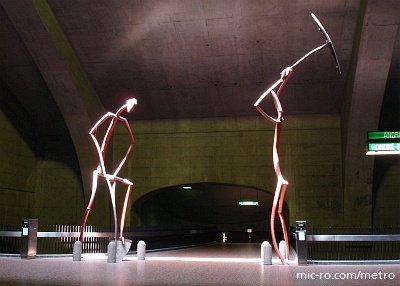 |
More than fifty stations are decorated with over hundred works of public art, such as sculptures, stained glass, and murals by noted artists from Québec. The city encourages this since 1967, one year after the opening of the system [stm.info], [metrodemontreal.com].
Photo: Huge sculptures by Germain Bergeron on the concourse level of Monk station on the Green Line. Monk station was opened in 1978. |
 | Some of Montreal's stations seem to be works of modern art themselves, and many reflect the zeitgeist of the decades they were built in.
Photo: Platform level of La Salle station (1978) on the Green Line. |
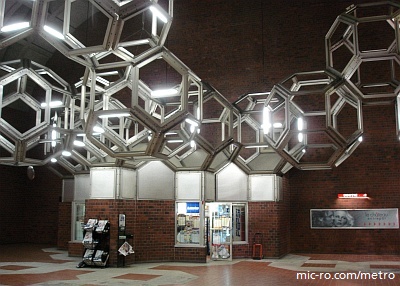 | Entrance buildings are often as well designed as the underground parts of the stations [metrodemontreal.com].
Photo: Concourse of Namur from 1984 station on the Orange Line.
 More Montréal photos... More Montréal photos... |
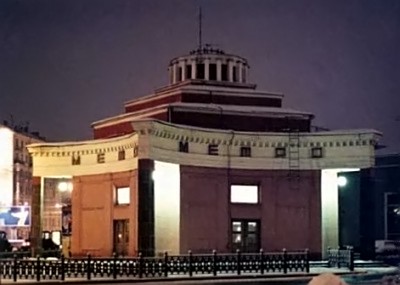 |
The metro opened in 1935. Many entrance buildings are just as architecturally spectacular as the stations below. Some stations are very deep and have been planned to serve as bomb shelters.
Photo [metro.ru]: Entrance building of Arbatskaya station on the first metro stretch from 1935. |
 | Moscow's metro stations are a heritage of the socialist regime, originally intended to be 'palaces for the people'. With their marble-clad walls, chandelier lighting, and other precious interior, many indeed resemble palaces or cathedrals [metro.ru], [metrowalks.ru], [beeflowers].
Photo [cla.purdue.edu]: Central part of the platform of Komsomolskaya station built in 1952 on the circle line. |
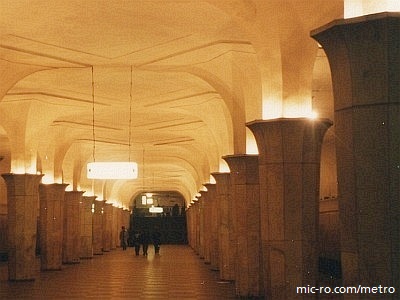 | Many sculptures, reliefs and murals are found in the stations [metrosoyuza.net]. Besides Moscow, some other cities of the former Soviet Union have metro stations of similar grandeur. However, the ones in Moscow are the most numerous and the most spectacular. Fortunately, even the new stations opened in the 21st century are of good architectural quality.
Photo: The platform of Kropotkinskaya station built in 1935.
 More Moscow photos... More Moscow photos... |
 |
This metro system has been opened in 1972 and has spacious and clean stations. The earlier ones are rather minimalistic in design while the later ones got more interesting architectural features and some works of art [muenchnerubahn.de], [oliverbarchewitz.de].
Photo: Dülferstraße station from 1993 by Peter Lanz and Jürgen Rauch. |
 | Photo: Westfriedhof station from 1998 with its simple concrete walls and its exceptional lighting concept by Ingo Maurer.
 More Munich photos... More Munich photos... |
 |
Line M1 has been turned into "Il Metro dell'Arte" as six stations have been upgraded with a lot of artworks [danpiz.net]. Museo station accommodates an archaeological exhibit of many objects found during metro construction [umuc.edu].
Photo [metro.na.it]: Museo station, opened in 2001. |
 | There are more interesting stations to follow when line M1 will be extended to finally become a circle line [contexttravel.com], [floornature.com].
Photo: Vanvitelli station, opened in 1993.
 More Naples photos... More Naples photos... |
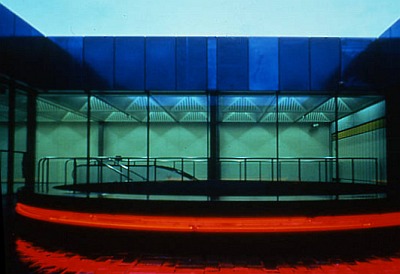 |
The Tyne and Wear Metro has a very consistently designed guiding system and many works of art in the stations [nexus.org.uk], [newcastle.gov.uk].
Photo [rwa.org.uk]: Interactive sculpture 'Pulse' of the year 2000 by Andrew Stonyer in the atrium of Four Lane Ends station: approaching trains cause the neon light to pulse.
 More Newcastle photos... More Newcastle photos... |
 |
Since the subway system was inaugurated in 1904 by the Interborough Rapid Transit Company (IRT) it has some interesting station design, above ground as well as below.
Photo: Reproduction of a historic stairway entrance kiosk at Brooklyn Bridge/City Hall station. It now houses an elevator to the station concourse. |
 | NYC's subway became a little neglected in the following decades and earned a reputation of crime and grime. But besides significantly improving all stations, trains, and the safety since the 1980's, MTA started to thoroughly refurbish 15 historic stations to their original appearance, e.g. 33rd Street. Ceramic wall decors and mosaic signs are present in most underground stations and come in a wide variety [Stookey, see Reference].
Photo: Ceramic station name mosaic at the refurbished 33rd Street station. |
 | MTA's 'Arts for Transit' program, founded in 1985, hosts more than 150 modern works of site-specific public art in stations [tfaoi.com], [nycsubway.org], [mta.info], [steelcase.com (PDF)].
Photo: Some of many humourous bronze sculptures, this is 'Life Underground' by Tom Otterness [tomostudio.com] in 14th Street station installed in 2004. |
 |
This city in northern Portugal got a light rail system in 2002. At street level, tracks are often embedded in grass. 15 of the 78 stations are underground [mporto.no.sapo.pt].
Photo [Nuno Fonseca, fotopic.net]: Entrance of Pólo Universitário station (2004). |
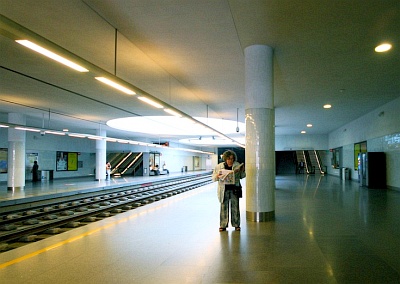 | Underground station architecture, surface-station furniture, signage and typography are quite consistent in their cool minimalistic elegance. Predominant materials are concrete, glass, and steel. Architect of all stations is Eduardo Souto de Moura, a former student of Alvaro Siza.
Photo [Paulo, skyscrapercity.com]: Casa da Musica station.
 More Oporto photos... More Oporto photos... |
 |
The distinctive, ornate, Art Nouveau metro entrances designed by Hector Guimard are a famous synonym for Paris's metro. Some are lost but 88 of them still exist [parisinconnu.com]. RATP has given reproductions to the subways in Chicago, Lisbon, Mexico City and the MoMA in New York, and an original entrance to Montreal [metrodemontreal.com].
Photo [Daniel Alhadeff]: The entrance at Porte Dauphine station, opened in 1900, is one of the larger ones. |
 | The elegant metro stations in Paris are mostly column-free vaults with white bevelled tiles that look similar throughout. The system was inaugurated in 1900. Everything has been refurbished for its 100th anniversary.
Photo [Mike Nguyen]: Cité station on line 4. |
 | An enjoyable architecture has also been implemented in Paris's newest RER stations as well as in the stations of the new driverless metro line 14 (Météor).
Photo: Magenta RER station with its interesting lighting.
 More Paris photos... More Paris photos... |
 |
This Italian people mover is called Minimetro and has seven stations. The elegant station buildings have been designed by the world famous French architect Jean Nouvel [minimetrospa.it], [flickr.com].
Photo [Alessio Monini, urbanrail.net]: Entrance structure at Cupa station of 2008, the only underground station in the system. |
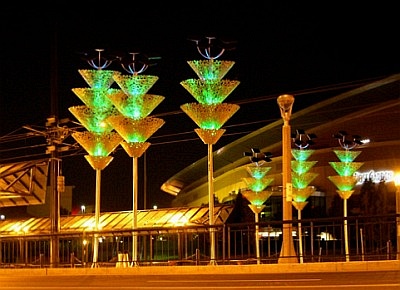 |
MAX light rail in Portland, Oregon, USA, consists of three lines running on streets or on their own right of way. The operators have integrated one or more works of art in almost every station to promote transit usage and community pride [trimet.org].
Photo [trimet.org]: Illuminated metal trees designed by Portland artist Brian Borrello generate their own electricity from solar panels at Interstate/Rose Quarter station (opened 2004) on the Yellow Line. |
 |
Some of the stations seem to be a homage to Victor Vasarely or kinetic artists of the 1970s. There are thousandfold repetitions of glass or aluminium elements with all stations looking different.
Photo: Jinonice station, built in 1988 on line B. Walls are covered with tube-shaped glass tiles. |
 | On line A, which was opened in 1978, station walls are covered with aluminium tiles which come in three versions (convex, concave or flat) and in different shades of colour. The designers thus managed to create a stunning, science-fiction-like appearance.
Photo: Flora station built in 1980 on line A.
 More Prague photos... More Prague photos... |
 |
The capital of North Korea has a socialist-style metro with murals and a grand architecture in a few stations [pyongyang-metro.com], [biglobe.ne.jp]. However, only two or three stations are open to tourists.
Photo [Wooolf, flickr.com]: Platform level of Puhung station. |
 |
 Rhine-Ruhr Rhine-Ruhr
The unique suspended monorail in the city of Wuppertal runs above the Wupper river and was opened in 1901. Some historic stations have been carefully restored and contrast in a nice way with rebuilt, architecturally interesting stations from the 1990's.
Photo: Landgericht station from 1903. |
 | Rhine-Ruhr area is an agglomeration of about 30 cities in western Germany with some 20 metro-tram lines and 9 S-Bahn lines [jochen-schoenfisch.de].
Photo: The combined metro-tram and bus station Neue Mitte, built in 1996 in the city of Oberhausen, was obviously influenced by deconstructivist architecture. |
 | There are at least a few remarkable stations in each of the cities of Bochum, Bonn, Cologne, Dortmund, Duesseldorf, Duisburg, Essen, Mulheim, and Wuppertal.
Photo: Lohring metro tram station from 2006 in the city of Bochum with a platform made of frosted glass, illuminated from below.
 More Rhine-Ruhr photos... More Rhine-Ruhr photos... |
 |
Only few stations in Rio are spectacular, but all are spacious and have little advertising. Many have marble walls and some are architecturally interesting. The metro was inaugurated in 1979.
Photo: Cardeal Arcoverde station in Copacabana, built in 2002.
 More Rio de Janeiro photos... More Rio de Janeiro photos... |
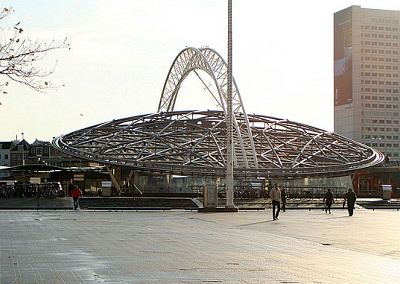 |
This metro was opened in 1968 and has some stations which are as futuristic as the city itself. Some stations contain works of art.
Photo [Denis Kabanov, urbanrail.net]: Entrance building of Blaak station (lines A, B, C). |
 | Other examples of interesting stations are Stadhuis (water flowing along vertical glass panels), Oostplein (glass windows in the floor) and some stations on line D between Marconiplein and Tussenwater [xs4all.nl/~kazil].
Photo: Wilhelminaplein station, built in 1997.
 More Rotterdam photos... More Rotterdam photos... |
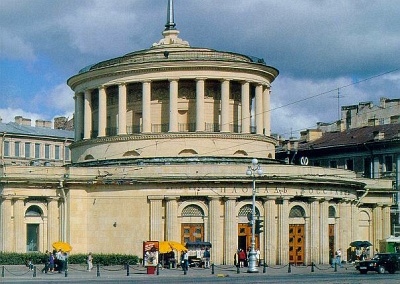 |
Outstanding, palace-like stations are found here, similar to those in Moscow [metrowalks.ru], [metrosoyuza.net]. Some of the older metro entrances are elaborate round buildings.
Photo [spb.metro.ru]: Entrance building of Ploshchad Vosstaniya station from 1955. |
 | Most stations in Saint Petersburg are of excellent architectural quality. Dazzling, themed metro stations are on the first metro stretch between Avtovo and Ploshchad Vosstaniya, which opened in 1955.
Photo: Platform of Avtovo station with 30 marble columns and 16 glass columns. |
 | The metro is the world's deepest with an average station being 60 meters below ground. Some stations double as bomb shelters.
Photo [metrowalks.ru]: Platform level of Krestovskiy Ostrov station from 1999.
 More Saint Petersburg photos... More Saint Petersburg photos... |
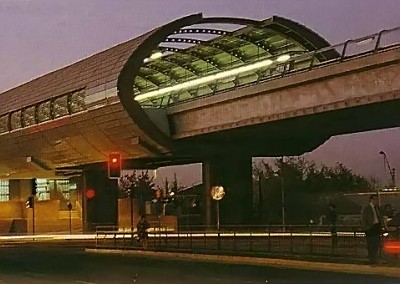 |
Chile's capital has some metro stations with spectacular yet diverse modern architecture.
Photo [railway-technology.com]: Mirador station built in 1997. |
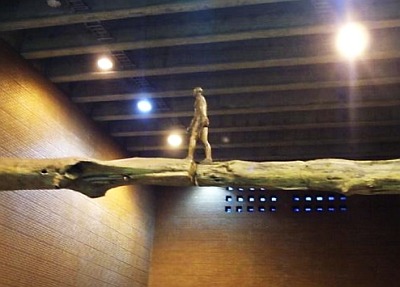 | There are also lots of works of art in Santiago's metro, like giant murals and sculptures, especially on line 5 [metrosantiago.cl].
Photo [skyscrapercity.com]: Baquedano station holds the 15 m wide sculpture "El Puente" from 1999 by Osvaldo Peña. |
 |
A diversity of geometrical forms were chosen for the underground stations [metro.sp.gov.br]. There's a collection of contemporary sculptures, installations and large murals in 30 of the 52 stations.
Photo [metro.sp.gov.br]: The mezzanine level of Brás station boasts 25 curved steel and polyurethane plates (2.2 m x 1 m each) which form the art installation 'Kaleidoscope' from 1999 by Amélia Toledo.
 More Sao Paulo photos... More Sao Paulo photos... |
 |
China's President Hu has declared that "Shanghai's Metro system in 2010 will become the biggest moving exhibition in the world" [beijing2008.cn].
Photo: The Bund Sightseeing Tunnel provides a spectacular ride under the river. Here's the view out of the front of one of the automated cabins.
 More Shanghai photos... More Shanghai photos... |
 |
The MRT has very clean stations, mostly with simple, modern designs. Newer stations have interesting architecture and works of art.
Photo [Calvin Teo, wikipedia.org]: Exterior of Expo station, opened in 2002, on the East-West Line. The station has been designed by Foster and Partners in collaboration with Arup. |
 | Many stations are intricately landscaped to reflect Singapore's reputation as a Garden City. Some underground stations are decorated with flowering orchids, tropical palms, or shrubs. City Hall and Raffles Place stations are good examples. On the North-East Line, which was inaugurated in 2003, all stations have individual architecture, and works of art have been integrated in every station [app-stg.lta.gov.sg].
Photo [deliarts.net]: Ceramic murals and floor mosaics in the concourse level of Dhoby Ghaut station. |
 |
Stockholm's tunnelbana is referred to as the world's longest art gallery because works of art have been integrated in almost every station since the 1950s. SL spends 10 million SEK per year in safeguarding and developing artwork.
Photo: Entrance of Odenplan station from 1952. |
 | Works of art can be found in 90 of the 100 stations. 140 artists have contributed so far.
Photo [from SL's free metro art booklet, see Reference]: Platform of T-Centralen station on the Blue Line, designed by Per Olof Ultvedt in 1975. |
 | Many stations in Stockholm, especially on the Blue Line, have been left as rock caverns, which gives them an outstanding, unique atmosphere.
Photo: Rinkeby station, built in 1975 on the Blue Line with gold mosaics, paintings, and sculptures.
 More Stockholm photos... More Stockholm photos... |
 |
Tashkent's metro, built in 1977, allegedly as one of the most beautiful in the former Soviet Union, consists of three lines. Leading architects and artists from Uzbekistan took part in creating unique stations, some of them decorated in Islamic designs.
Photo [ilkhom.ferghana.ru]: Ceiling of Navoiy station from 1984. |
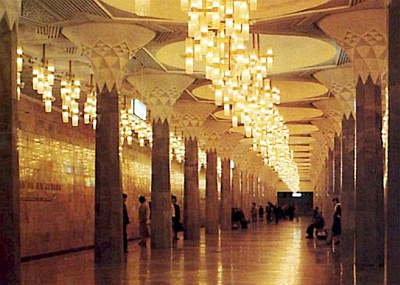 | Enduring materials have been used for Tashkent's station interiors, like engraved metal, glass, granite, marble, or carved alabaster. Each station's design is distinct and devoted to a certain theme.
Photo [crafts.freenet.uz]: Mustaqilik Maidoni station from 1977. |
 |
The clean metro system in the capital of Iran has many stations with an interesting architecture or design.
Photo [u-bahn-blog.de]: Entrance of Imam Khomeini station, opened in 2000. |
 | Works of art have been integrated in many stations [tehranmetro.com], [iranchamber.com] as well as some stunning architectural features.
Photo [tehranmetro.com]: Platform level of Mirdamad station from 2002. |
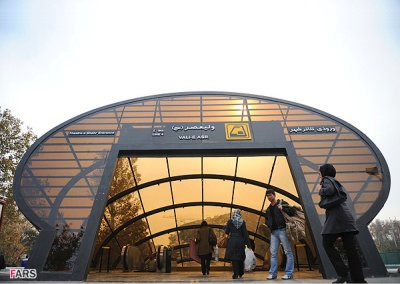 | Photo [Hossein Mosavi Faraz, Fars News Agency]: Entrance structure of Vali-E Asr station from 2010. |
 |
All stations on Tokyo's Oedo line (opened in 2000) have been created by different well reputed architects, selected through a design competition [g-mark.org], [makoto-architect.com], [jrtr.net (PDF)]. The organic designs on platform and street levels of Iidabashi station are the world's first examples of computer-generated "evolutionary architecture", as architect Makoto Watanabe describes it in his book (see Reference).
Photo [gandamu]: Entrance of Iidabashi station. |
 |
Most stations are looking more or less alike, except for the colour schemes of the wall tiles. But TTC's Art in Architecture Program has integrated a considerable collection of public art into the stations [transit.toronto.on.ca].
Photo [Craig James White, flickr.com]: Dupont station from 1978 on the Yonge-University-Spadina Line. |
 | Especially the new Sheppard Line has some interesting stations [city.toronto.on.ca]. Furthermore, the Arts on Track Project aims to revitalize a couple of older stations through donations [tcf.ca].
Photo [Craig James White, flickr.com]: One of the many optical illusions by Toronto artist Panya Clark Espinal at Bayview station from 2002 on the Sheppard Line [haha.nu]. |
 |
All stations have works of arts, mostly on the concourse levels.
Photo: Mirail Université station of 1993 on line A with a tall tree-like sculpture and other works of art by Daniel Coulet. |
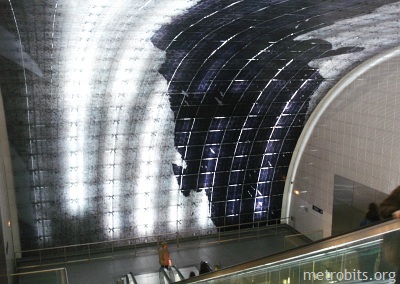 | Stations are spacious and of varied architecture.
Photo: Carmes station of 2007 on line B with a huge 'sky' by Jean-Paul Marcheschi. This piece of art is a staggering 14 x 35 m (46 x 115 ft) and curves along the ceiling and wall.
 More Toulouse photos... More Toulouse photos... |
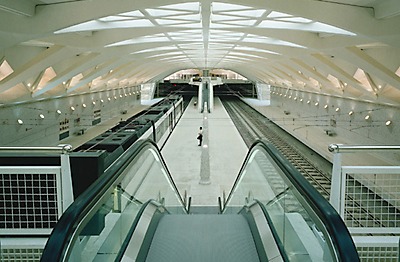 |
This metro in Spain has several very different stations with interesting architecture.
Photo [calatrava.com]: Alameda station, designed by the architect Santiago Calatrava. |
 |
Vancouver's LRT is called Skytrain as it runs elevated except for four underground stations in downtown. The Millennium Line extension built in 2002 includes a couple of interesting stations which incorporate organic designs, west-coast wood architecture and modern metal-and-glass designs.
Photo [archiseek.com]: Brentwood station, designed by Peter Busby and Associates architects. |
 |
The Art Nouveau Stadtbahn stations have been consistently planned by the renowned architect Otto Wagner and date back as far as 1898 when the city rail system was inaugurated [wiennet.at]. Most stations have been beautifully renovated and integrated into the metro system.
Photo [bigfoto.com]: Karlsplatz station pavilion built in 1898. |
 | Some of Vienna's elegant modern metro stations are decorated with works of art.
Photo [hs-st-paul.ksn.at]: Volkstheater station with mosaic friezes by Anton Lehmden. |
 |
The Metrorail system of the US capital has been designed by Harry Weese & Associates to be America's grandest subway and was inaugurated in 1976. The Commission of Fine Arts, which had to approve the station design, favoured the coffered vaults [chnm.gmu.edu], [railwayage.com].
Photo: Capitol South station, built in 1977. |
 | Works of art can be found in many stations [wmata.com/about/]. All stations above ground in Washington, as well as the underground ones, have been constructed using the same selection of materials consistently throughout the system. A useful feature are the rows of lamps on all platform edges which start flashing when a train approaches.
Photo: Arlington Cemetery station from 1977. |












































































































